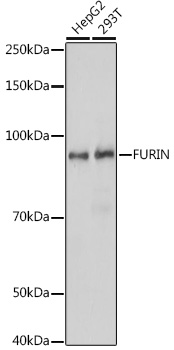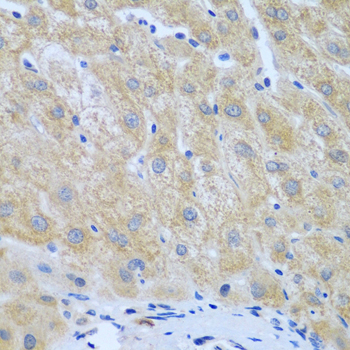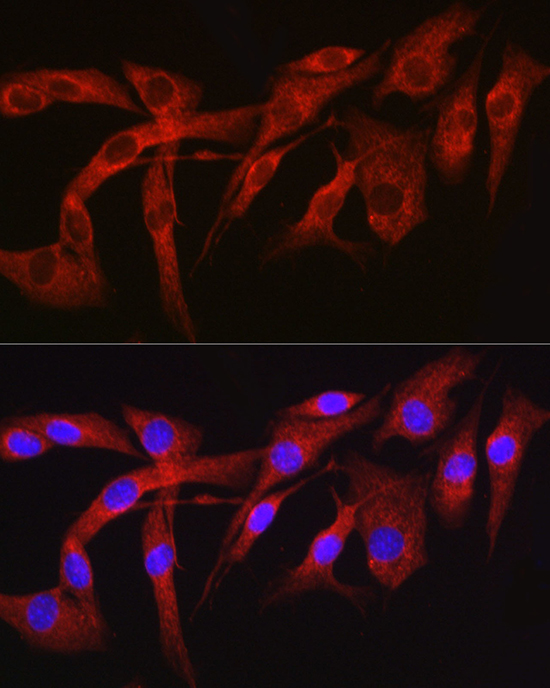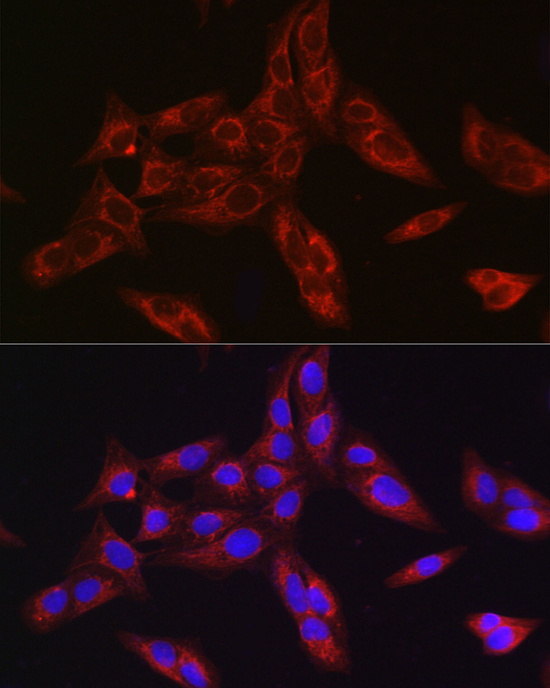Immunology Antibodies 2
Anti-FURIN Antibody (CAB7445)
- SKU:
- CAB7445
- Product Type:
- Antibody
- Reactivity:
- Human
- Reactivity:
- Mouse
- Reactivity:
- Rat
- Host Species:
- Rabbit
- Isotype:
- IgG
- Antibody Type:
- Polyclonal Antibody
- Research Area:
- Immunology
Description
| Antibody Name: | Anti-FURIN Antibody |
| Antibody SKU: | CAB7445 |
| Antibody Size: | 20uL, 50uL, 100uL |
| Application: | WB IHC IF |
| Reactivity: | Human, Mouse, Rat |
| Host Species: | Rabbit |
| Immunogen: | Recombinant fusion protein containing a sequence corresponding to amino acids 120-370 of human FURIN (NP_002560.1). |
| Application: | WB IHC IF |
| Recommended Dilution: | WB 1:500 - 1:2000 IHC 1:50 - 1:200 IF 1:50 - 1:200 |
| Reactivity: | Human, Mouse, Rat |
| Positive Samples: | HepG2, 293T |
| Immunogen: | Recombinant fusion protein containing a sequence corresponding to amino acids 120-370 of human FURIN (NP_002560.1). |
| Purification Method: | Affinity purification |
| Storage Buffer: | Store at -20'C. Avoid freeze / thaw cycles. Buffer: PBS with 0.02% sodium azide, 50% glycerol, pH7.3. |
| Isotype: | IgG |
| Sequence: | QQWY LSGV TQRD LNVK AAWA QGYT GHGI VVSI LDDG IEKN HPDL AGNY DPGA SFDV NDQD PDPQ PRYT QMND NRHG TRCA GEVA AVAN NGVC GVGV AYNA RIGG VRML DGEV TDAV EARS LGLN PNHI HIYS ASWG PEDD GKTV DGPA RLAE EAFF RGVS QGRG GLGS IFVW ASGN GGRE HDSC NCDG YTNS IYTL SISS ATQF GNVP WYSE ACSS TLAT TYSS GNQN EKQI VTTD LRQK CTES HTGT SAS |
| Gene ID: | 5045 |
| Uniprot: | P09958 |
| Cellular Location: | Cell membrane, Golgi apparatus, Single-pass type I membrane protein, trans-Golgi network membrane |
| Calculated MW: | 86kDa |
| Observed MW: | 90KDa |
| Synonyms: | FURIN, FUR, PACE, PCSK3, SPC1, furin |
| Background: | This gene encodes a member of the subtilisin-like proprotein convertase family, which includes proteases that process protein and peptide precursors trafficking through regulated or constitutive branches of the secretory pathway. It encodes a type 1 membrane bound protease that is expressed in many tissues, including neuroendocrine, liver, gut, and brain. The encoded protein undergoes an initial autocatalytic processing event in the ER and then sorts to the trans-Golgi network through endosomes where a second autocatalytic event takes place and the catalytic activity is acquired. The product of this gene is one of the seven basic amino acid-specific members which cleave their substrates at single or paired basic residues. Some of its substrates include proparathyroid hormone, transforming growth factor beta 1 precursor, proalbumin, pro-beta-secretase, membrane type-1 matrix metalloproteinase, beta subunit of pro-nerve growth factor and von Willebrand factor. It is also thought to be one of the proteases responsible for the activation of HIV envelope glycoproteins gp160 and gp140 and may play a role in tumor progression. This gene is located in close proximity to family member proprotein convertase subtilisin/kexin type 6 and upstream of the FES oncogene. Alternative splicing results in multiple transcript variants. |
| UniProt Protein Function: | FURIN: Furin is likely to represent the ubiquitous endoprotease activity within constitutive secretory pathways and capable of cleavage at the RX(K/R)R consensus motif. Belongs to the peptidase S8 family. Furin subfamily. |
| UniProt Protein Details: | Protein type:EC 3.4.21.75; Vesicle; Protease; Cell surface; Membrane protein, integral Chromosomal Location of Human Ortholog: 15q26.1 Cellular Component: Golgi membrane; extracellular space; trans-Golgi network transport vesicle; cell surface; membrane; Golgi lumen; integral to membrane; plasma membrane; trans-Golgi network; lipid raft Molecular Function:peptidase activity; serine-type endopeptidase inhibitor activity; protease binding; metal ion binding; serine-type endopeptidase activity; endopeptidase activity; nerve growth factor binding; peptide binding Biological Process: extracellular matrix organization and biogenesis; viral reproduction; nerve growth factor receptor signaling pathway; peptide hormone processing; regulation of signal transduction; pathogenesis; viral infectious cycle; proteolysis; positive regulation of membrane protein ectodomain proteolysis; peptide biosynthetic process; nerve growth factor processing; extracellular matrix disassembly; transforming growth factor beta receptor signaling pathway; regulation of endopeptidase activity; negative regulation of nerve growth factor production; secretion by cell; Notch signaling pathway; signal peptide processing; virus assembly; post-translational protein modification; peptidyl-glutamic acid carboxylation; nerve growth factor production; negative regulation of transforming growth factor-beta1 production; collagen catabolic process; cell proliferation; cellular protein metabolic process; viral protein processing; protein processing; regulation of protein catabolic process; negative regulation of low-density lipoprotein receptor catabolic process |
| NCBI Summary: | This gene encodes a member of the subtilisin-like proprotein convertase family, which includes proteases that process protein and peptide precursors trafficking through regulated or constitutive branches of the secretory pathway. It encodes a type 1 membrane bound protease that is expressed in many tissues, including neuroendocrine, liver, gut, and brain. The encoded protein undergoes an initial autocatalytic processing event in the ER and then sorts to the trans-Golgi network through endosomes where a second autocatalytic event takes place and the catalytic activity is acquired. The product of this gene is one of the seven basic amino acid-specific members which cleave their substrates at single or paired basic residues. Some of its substrates include proparathyroid hormone, transforming growth factor beta 1 precursor, proalbumin, pro-beta-secretase, membrane type-1 matrix metalloproteinase, beta subunit of pro-nerve growth factor and von Willebrand factor. It is also thought to be one of the proteases responsible for the activation of HIV envelope glycoproteins gp160 and gp140 and may play a role in tumor progression. This gene is located in close proximity to family member proprotein convertase subtilisin/kexin type 6 and upstream of the FES oncogene. Alternative splicing results in multiple transcript variants. [provided by RefSeq, Jan 2014] |
| UniProt Code: | P09958 |
| NCBI GenInfo Identifier: | 120611 |
| NCBI Gene ID: | 5045 |
| NCBI Accession: | P09958.2 |
| UniProt Secondary Accession: | P09958,Q14336, Q6LBS3, Q9UCZ5, |
| UniProt Related Accession: | P09958 |
| Molecular Weight: | 86,678 Da |
| NCBI Full Name: | Furin |
| NCBI Synonym Full Names: | furin (paired basic amino acid cleaving enzyme) |
| NCBI Official Symbol: | FURIN |
| NCBI Official Synonym Symbols: | FUR; PACE; SPC1; PCSK3 |
| NCBI Protein Information: | furin; FES upstream region; dibasic processing enzyme; furin, membrane associated receptor protein; proprotein convertase subtilisin/kexin type 3; paired basic amino acid residue-cleaving enzyme |
| UniProt Protein Name: | Furin |
| UniProt Synonym Protein Names: | Dibasic-processing enzyme; Paired basic amino acid residue-cleaving enzyme; PACE |
| Protein Family: | Furin |
| UniProt Gene Name: | FURIN |
| UniProt Entry Name: | FURIN_HUMAN |











